调节介孔中熵合金纳米酶的p-d轨道杂化,增强过氧化物酶样活性。
IF 16
1区 材料科学
Q1 CHEMISTRY, MULTIDISCIPLINARY
引用次数: 0
摘要
铂基纳米酶在活化H2O2方面表现出优异的稳定性和催化活性,使其成为免疫分析应用中理想的过氧化物酶(POD)类替代品。然而,Pt和氧基中间体之间过多的轨道重叠阻碍了特定的催化进展。本文报道了一种高效的介孔中熵合金(m-MEA)纳米酶,通过多种元素的协同作用选择性地提高POD活性。这种协同作用降低了Pt的5d轨道能量,从而降低了反键能级,减弱了o2p和Pt 5d之间的p-d轨道杂化。轨道重叠的减少降低了能垒,抑制了氧合中间体(*OH2/*OH)的过度吸附,减弱了活性位点的氧中毒。此外,m-MEA纳米酶暴露的介孔结构保证了活性位点的可达性,使其POD比活性达到304±1.69 U mg-1,分别比介孔Pt纳米酶和无孔MEA纳米酶高6.58倍和507倍。基于m- mea的免疫分析平台已被用于前列腺特异性抗原的检测,其检测限极低,仅为1.20 pg mL-1,超过了传统酶联检测的灵敏度。本文章由计算机程序翻译,如有差异,请以英文原文为准。
Modulating p-d Orbital Hybridization in Mesoporous Medium-Entropy Alloy Nanozymes with Enhanced Peroxidase-Like Activity.
Platinum (Pt)-based nanozymes display exceptional stability and catalytic activity in the activation of H2O2, making them ideal peroxidase (POD)-like substitutes for immunoassay applications. However, specific catalytic progress is hindered by the excessive orbital overlaps between Pt and oxygen-based intermediates. Herein, a highly efficient mesoporous medium-entropy alloy (m-MEA) nanozyme is reported to selectively enhance POD activity through synergy interaction of multiple elements. Such synergy reduces the 5d orbital energy of Pt, thereby lowering antibonding energy levels and weakening p-d orbital hybridization between the O 2p and Pt 5d. The reduced orbital overlap lowers energetic barriers and suppresses the excessive adsorption of oxygenated intermediates (*OH2/*OH), as well as weakens oxygen poisoning of active sites. In addition, the exposed mesoporous structure of m-MEA nanozyme ensures accessible active sites, resulting in a high POD specific activity of 304 ± 1.69 U mg-1, which is 6.58- and 507-folds higher than that of mesoporous Pt and nonporous MEA nanozymes, respectively. The m-MEA-based immunoassay platform has been utilized for the detection of prostate-specific antigens, achieving an exceptionally low detection limit of 1.20 pg mL-1, surpassing the sensitivity of traditional enzyme-linked assays.
求助全文
通过发布文献求助,成功后即可免费获取论文全文。
去求助
来源期刊

ACS Nano
工程技术-材料科学:综合
CiteScore
26.00
自引率
4.10%
发文量
1627
审稿时长
1.7 months
期刊介绍:
ACS Nano, published monthly, serves as an international forum for comprehensive articles on nanoscience and nanotechnology research at the intersections of chemistry, biology, materials science, physics, and engineering. The journal fosters communication among scientists in these communities, facilitating collaboration, new research opportunities, and advancements through discoveries. ACS Nano covers synthesis, assembly, characterization, theory, and simulation of nanostructures, nanobiotechnology, nanofabrication, methods and tools for nanoscience and nanotechnology, and self- and directed-assembly. Alongside original research articles, it offers thorough reviews, perspectives on cutting-edge research, and discussions envisioning the future of nanoscience and nanotechnology.
 求助内容:
求助内容: 应助结果提醒方式:
应助结果提醒方式:


